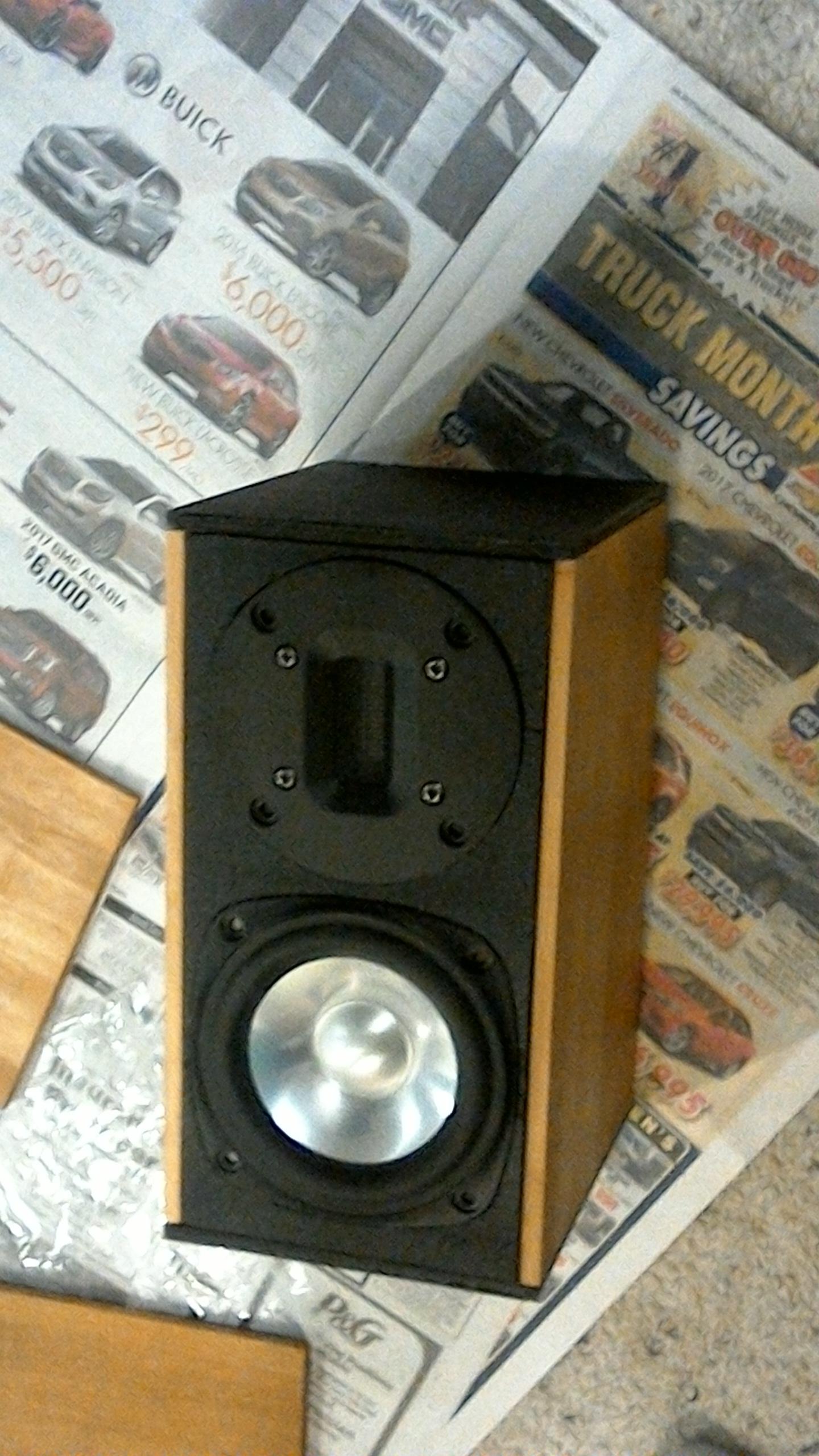Site Links
Howdy, Stranger!
It looks like you're new here. If you want to get involved, click one of these buttons!
Quick Links
Categories
In this Discussion
Please review the site Rules, Terms of Service, and Privacy Policy at your convenience. Rules, TOS, Privacy
Get familiar with the reaction system: Introducing the Reaction System
Rhodium - A nanotech ribbon monitor
 I am planning to bring a nanotech project to Indy this year. I've done several small designs, so I wanted to try something a little more upscale this time. It turns out that the SB Acoustics SB12PAC works well in 3L vented has a well ventilated frame and promising published measurements. I will be pairing that with the Fountek NeoCD 1.0. The recent amazing weather led to some garage time, so I have a dry fit image to share. Assembly and crossover work to follow...
I am planning to bring a nanotech project to Indy this year. I've done several small designs, so I wanted to try something a little more upscale this time. It turns out that the SB Acoustics SB12PAC works well in 3L vented has a well ventilated frame and promising published measurements. I will be pairing that with the Fountek NeoCD 1.0. The recent amazing weather led to some garage time, so I have a dry fit image to share. Assembly and crossover work to follow...






Comments
Ron
Sehlin Sound Solutions
http://techtalk.parts-express.com/forum/tech-talk-forum/68562-dayton-nd105-4-fountek-neocd1-0-project
Ron
Sehlin Sound Solutions
Javad
Javad
Sehlin Sound Solutions

The on-axis measured frequency response measurements are shown below. Sensitivity is nominally 81 dB (2.83V, 1 meter). These measurements were actually taken with 2V input at 0.5 meters, which theoretically give the same result.The yellow curve is the on axis response, red is woofer plus crossover, light blue is tweeter plus crossover, royal blue is with tweeter polarity reversed. Response is very smooth through the midrange with a slight elevation centered around 2kHz and slightly lower response between 4 and 10kHz. The crossover point is about 4.25 kHz and slopes are nominally 4th order LR. The deep reverse null indicates phase alignment between the drivers at the crossover point
Horizontal off-axis measurements were taken at 15 (red), 30 (lt. blue), 45 (royal blue), and 60 (orange) degrees.
I like to think this makes sense. The elevated on-axis response from 1-3 kHz coincides with reduced off axis response and the elevated off-axis response 4-6 kHz coincides with reduced on-axis response. The ribbon tweeter has great horizontal dispersion, being only about 10 dB down 60 degrees off-axis out to 20 kHz.
The impedance plot shows a port tuning frequency of approximately 67 Hz. The SB12PAC is a 4 ohm woofer, so low impedance was a concern with this design. As it turned out, the minimum impedance is 3.6 ohms at around 250 Hz, so this shouldn't be a severe load for most receivers/amps.
Sehlin Sound Solutions
The cabinet sides were cut from 3/8" thick bamboo cutting boards. The remainder is 1/2" birch plywood painted with black duratex. The rear panel includes a standard Parts Express 1" diameter by 4" long port and a small round terminal cup.
I decided to make the rear panel removable for ease of construction and modification.
There is quite a bit to discuss here - I'll do my best to hit the important details. The crossover is mounted to the bottom of the cabinet on 2" x 3" pegboard. Full disclosure: the L2 inductor was scavenged from an old Klipsch enclosure and is probably a 22-24 gauge air core. C1 is an electrolytic cap, because that is what I had on hand at that value.
For rear mounting, I used EZ-Lok threaded inserts and glued plywood strips to the top and bottom of the inside rear of the cabinet to hold them.
For damping, I used self adhesive roof repair sheet on the bamboo sides and rear of the cabinet. I then added a chunk of R13 ultratouch denim insulationI hop to the rear panel. Finally, a thin layer of weather stripping goes around the outside of the rear panel to ensure a good seal for the removable panel.
I was worried about the thin bamboo ringing, so I wedged a couple of plywood strips between the side walls. The side walls already had damping material applied, so the braces press against that, creating a constrained layer effect, at least for the area in which the braces are in contact with the side walls.
From this view, you can also see the general construction approach.
The front and rear are simple 4.5" by 9" by 1/2" panels with the required cutouts. The position of the rear port allows it to extend between the woofer magnet and tweeter transformer assembly. If it is located higher or lower, it will hit something. The driver flanges barely fit on the baffle, so there really isn't any choice where to mount them. The woofer flange is pretty thick, which has the effect of allowing the rear of the woofer to be exposed well enough without the need to bevel the woofer cutout.
The bamboo side panels are 9" tall by 6" wide with 1/2" wide by 1/8" deep rabbets along the long sides to accept the baffle and rear panel.
The end caps are 6" by 5" with 1/4" deep rabbets all the way around. On the 6" side, the rabbets are 3/8" wide. On the 5" side, they are 1/2" wide.
I hope that gives enough information for anyone who might be interested in building the Rhodiums.
Sehlin Sound Solutions
Sehlin Sound Solutions